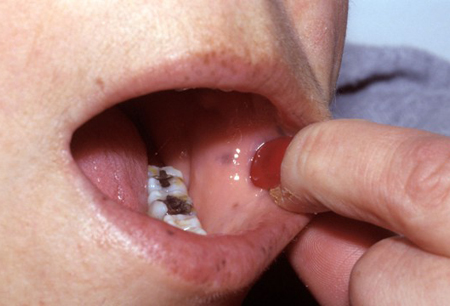History and exam
Key diagnostic factors
common
small intestinal obstruction
mucocutaneous pigmentation
Present in about 95% of cases.[20] Occurs most commonly on the vermillion border of the lips (94%), buccal mucosa (66%), hands (74%), and feet (62%), but has also been reported in the periorbital, perianal, and genital areas.[20]
Typically manifests as small, dark brown or blue-brown macules in infancy that often fade in late adolescence. The buccal lesions usually persist.[17][Figure caption and citation for the preceding image starts]: Characteristic pigmentation present on lips and buccal mucosaFrom the collection of Dr Carol A. Burke, used with permission [Citation ends].
Other diagnostic factors
common
abdominal discomfort and distension
Abdominal discomfort and distension are common symptoms of Peutz-Jeghers syndrome. Polyp growth begins in childhood by age 10 years, with most experiencing symptoms such as bleeding, abdominal pain, intussusception, or obstruction by age 18 years.[18]
uncommon
gastrointestinal bleeding
polyp prolapse per anus
Initial presentation in 7% of patients.[20]
enlarged testicles (without masses)
May suggest an underlying testicular tumor. Boys with Peutz-Jeghers syndrome are at risk for Sertoli cell tumors that can cause gynecomastia and other signs of hyperestrogenism and occasionally virilization and/or accelerated height growth.[18] The average age of diagnosis for testicular cancer is 9 years, with a range of 3-20 years.[21]
bilateral gynecomastia
May suggest an underlying Sertoli cell tumor.
fatigue
Due to anemia with colonic polyps.
pallor
Due to anemia with colonic polyps.
Risk factors
strong
positive family history
Peutz-Jeghers syndrome (PJS) is inherited in an autosomal-dominant fashion in most patients. Each child of an affected parent has a 50% chance of inheriting PJS. Approximately 25% of patients newly diagnosed with PJS have de novo mutations.[8]
Use of this content is subject to our disclaimer